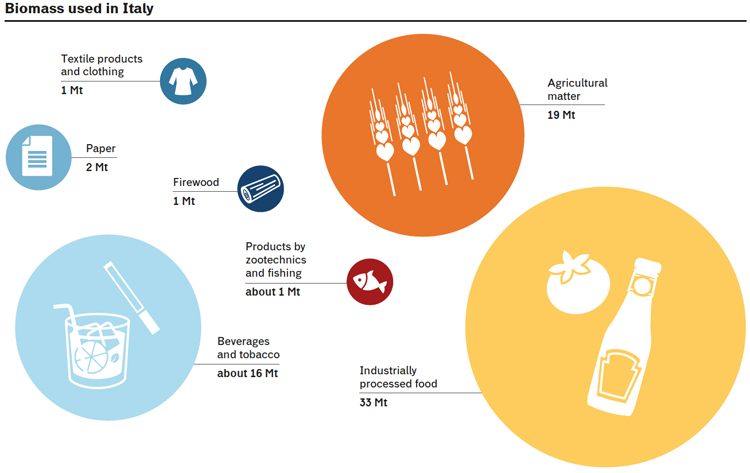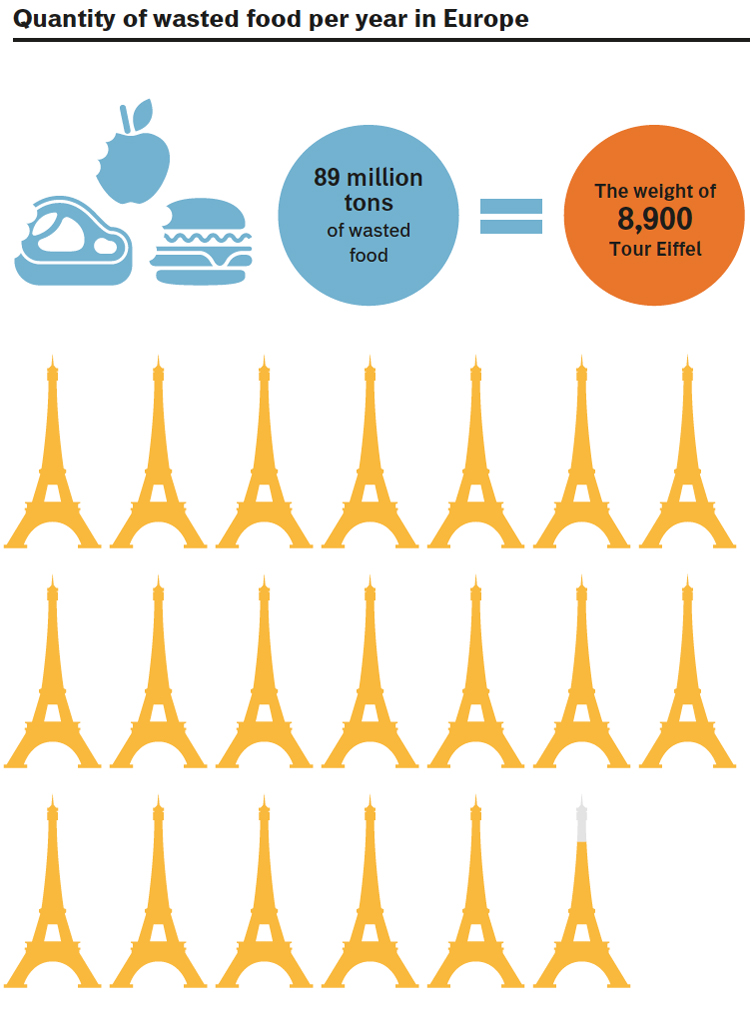An ideal circular economy is one that, beyond circulating as much as possible materials in the community before giving them back to nature, gives them back paying attention to replenish natural stocks where they have been undermined. Therefore creating a condition of equilibrium between natural materials input and output where the repetition of starting conditions secures – theoretically to infinity – the reproducibility of the economic process.
The essential renewability condition about biomass cycles is the conservation of balance in nutrients stocks and in the composition of topsoil, especially for the organic component. The soil, indeed, provides nitrogen, phosphorus, potassium and other chemicals to the plants, that get the other elements they need from water and the atmosphere (carbon, hydrogen and oxygen). Yes, there’s no guarantee that human consumption model will maintain a balance between flows and right composition of stocks, but certainly if part of the biomass ending up in landfills, the nutrients in it are not given back to the soil where come from. These shortages can be – and indeed are – locally offset with mineral and synthetic inputs (in fact, over-offset, with negative consequences on water quality). But in this way the physical cost of this real nutrients squandering is only transferred somewhere else, due to matter and energy needed for producing synthetic fertilizers and to atmospheric emissions of chemical compounds.
So the design of usage chains must be part of a global system and they must tend to close cycles and reduce squandering about biomass in general and the leftover part in particular, favouring the small scale and local level to have a accounting of environmental costs of cropping and transportation.
Biomass from agricultural and forestry practices, from zootechnics, organic waste from farms and the wood-paper chain and the organic part of municipal solid waste are the core of two chains tending to close cycles: composting and energy recovery through anaerobic digestion. These allow to close the nutrients cycle while maintaining the fertility of soil, using compost and digested material as soil inputs while improving the carbon exchange balance with the atmosphere.
Some numbers can help us figure out an overall picture.
We have two apparently very different assessments about the entity of residual biomass from primary activities. ISPRA (Istituto Superiore per la Protezione e la Ricerca Ambientale/The Institute for Environmental Protection and Research), in 2006 evaluated them as 18 Mt for Italy, but considering only the main crops and expressing data as “dry material”. The other one is the most complete assessment and is expressed in weight “as is”, provided by SERI (Sustainable Europe Research Institute) in Vienna: about 76 Mt (year 2011). Indeed, the methodological differences in these two assessments can be dramatically reduced actualizing them, spreading them to all crops and expressing them in terms of weight “as is”. In this way we reach at least 60 Mt. The residual difference is likely due to inclusion in SERI’s assessment of parts of plants not included in ISPRA’s one (e.g. roots, woody plants ending their life-cycle) and to the use of specific coefficients for Italian cultivar.
In addition, ISPRA’s study – in order to establish the potential for energy recovery from these and other combustible and residual biomasses – highlights other topics that must be considered: the periodicity of availability for these materials, the pulverized distribution with related costs for collection and transportation. Concluding that “any technical-economic feasibility evaluation for their recovery must be done at the local level”. Finally, ISPRA points out, 43% of dry matter and one third of actual weight is already being used; and meanwhile this share has probably grown. We need to point out that quantity esteem and knowing the actual destination of crops and pruning waste could be made, for recent years, more simple and accurate by ISTAT introducing some ad hoc questions in agricultural sector structural surveys.
The 2013 animal dropping esteem, obtainable from data supplied by CRPA (Centro Ricerche Produzione Animale/Research Centre on Animal Production) and reported in ISPRA’s study is 117 Mt, including sewage (68 Mt) and manure (49 Mt). Most of the manure is given back to soil, but the energy recovery usage is rapidly growing. Among the 312 anaerobic digestion plants for biogas production recorded by ISPRA in 2007, the ones processing sewage and manure were 147, exclusively (88) or in combination with organic waste (from agro-industrial activities and organic fraction of Msw) and/or crops totally used for energy production, with a total usage of about 3 Mt of matter per year. Over the last 7 years we reached about 1,300 plants (including the ones processing slurry from municipal water treatment plants) with an installed power of 1,000 MWe, and as Piero Gattoni (President of CIB, Italian Biogas Consortium) stated in an interview with the Italian newspaper La Stampa, it is provided that “an increase to about 2,300 plants and double the current installed power is expected by 2030”.
In Italy the amount of used biomass, excluding the crops waste not given to the market, shows that inputs to household final consumption reach a total of about 73 Mt. Only 3 Mt of these are recovered as composting waste. Of course, not all the 73 Mt could be recovered: about 16 Mt are beverages and tobacco, 2 Mt are paper, 1 Mt is textile products and clothing and 1 Mt is firewood. So the remaining part is made of 53 Mt of agricultural matter (19 Mt), products by zootechnics and fishing (about 1 Mt), and industrially processed food (33 Mt). Allowing a large uncertainty range, we can say that these two last voices equal 27 Mt of dry matter.

About food squandering, a 2011 survey by Dipartimento di Scienze e Tecnologie Alimentari at Università di Bologna assessed it as 20 Mt for the whole food farming chain. In the same year a report by European Commission esteemed the amount of wasted food in 89 million tons per year, that is 179 kg per person. For Italy this means 10.8 Mt, an amount more compatible with the 7 Mt of industrial leftovers we esteemed (not completely wasted), and to this we must add household squandering. More than 40% of total food squandering happens, indeed, at household level. According to data provided by ADOC (Associazione per la Difesa e l’Orientamento dei Consumatori/Association for the Defense and the Consumer Orientation) “35% of fresh products, 19% of bread, and 16% of fruit and vegetables” goes into garbage. “Without taking into consideration squandering by restaurants, bars and canteens”.

In 2012, to produce what was squandered, 143,100 tons of reactive nitrogen were emitted into the environment (while 85,800 tons of nitrogen were wasted due to losses along the chain). Accepting as good that 40% of squandering in the food chain is due to household final consumption, and applying it to estimated 20 Mt of total squandering, we have 4.3 Mt of food wasted by families, that is 8% of 53 Mt delivered to consumers.
Biomasses consumed by humans (about 5 Mt of excrements expressed in dry matter) also represent a valorized resource in biogas production. Part of these, indeed, after water treatment feed digesters for biogas production (up to 40% of those recorded in 2007).
The numbers provided here, as well as the ones in previous articles, are just some of the numbers needed to figure out a general quantitative picture of biomasses usage cycles. We could provide many more: for instance some details on composition and destination of leftovers from food farming industries and from wood-paper chain, or – for some topics – territorial details. However, unfortunately, we don’t see through them a complete and consistent picture exact enough to plan a widespread circular economy necessary for Italian biomasses.
Bibliography
- European Commission – DG Environment Unity C1, Food Waste in the EU: a study by the European Commission, Workshop on Municipal Waste Prevention, Barcellona, November 24th, 2011
- Waste Watcher – Knowledge for Expo 2015, www.lastminutemarket.it/media_news/wp-content/uploads/2014/05/Knowledge-for-Expo-Rapporto-2014.pdf
- Segrè A., L. Falasconi, Il libro nero dello spreco in Italia: il cibo, Edizioni Ambiente 2011
- 4. SDA Bocconi, Analisi della filiera del compostaggio, giugno 2014, www.slideshare.net/MilanoRecycleCity/analisi-della-filiera-del-compostaggio
- WWF Italia, Quanta natura sprechiamo? Le pressioni ambientali degli sprechi alimentari in Italia, Roma 2013, awsassets.wwfit.panda.org/downloads/report_quanta_natura_sprechiamo_ottobre_2013.pdf
- Ispra, Rapporto rifiuti 2013
- Istat, annali di statistica, serie XI vol. 2, Contabilità ambientale e pressioni sull’ambiente naturale: dagli schemi alle realizzazioni, pp. 176-181
- Istat, Questionario e libretto indagini: legnose agrarie e Spa
- La Stampa, interview to Piero Gattoni, president of Consorzio italiano biogas, 2/1/2015, www.lastampa.it/2015/02/01/scienza/ambiente/focus/biogas-litalia-terzo-produttore-al-mondo-dopo-germania-e-cina-OSjLZIsghgUmMloNF7mxIN/pagina.html
- Piccinini S., M. Soldano, C. Fabbri, “La produzione di biogas del settore agricolo in Italia”, Agriregionieuropa, anno 7, 24, marzo 2011, agriregionieuropa.univpm.it/content/article/31/24/la-produzione-di-biogas-del-settore-agricolo-italia
Top image: ©Gesina Roters, Dutch postal stamps on the theme of recycling and energy savings, 2011

